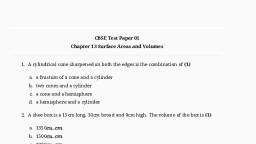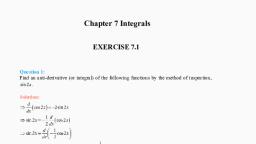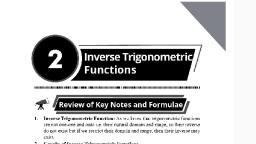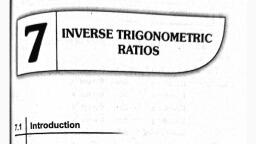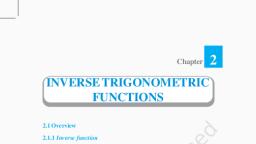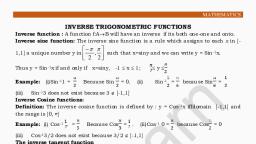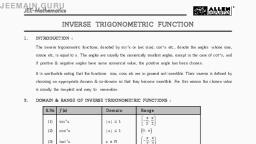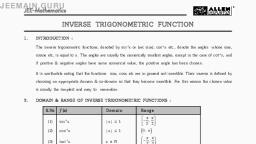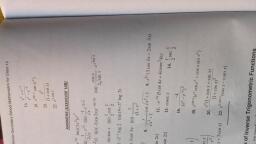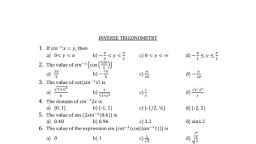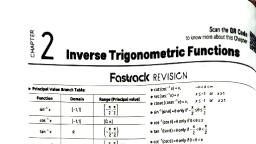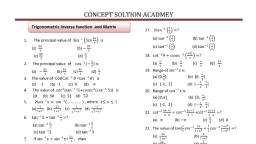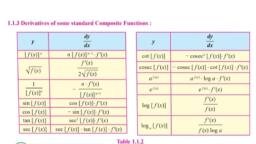Page 1 :
Inverse Trigonometric Functions, , , If sin y = x, then y = sin–1x (We read it as sine inverse x), Here, sin–1x is an inverse trigonometric function. Similarly, the other inverse trigonometric, functions are as follows:, , o, o, o, o, o, , If cos y = x, then y = cos–1x, If tan y = x, then y = tan–1x, If cot y = x, then y = cot–1x, If sec y = x, then y = sec–1x, If cosec y = x, then y = cosec–1x, , , , The domains and ranges (principle value branches) of inverse trigonometric functions can, be shown in a table as follows:, Function, , Domain, , y = sin–1x, , [–1, 1], , y = cos–1x, , [–1, 1], , y = tan–1x, , R, , y = cot–1x, , R, , y = sec–1x, , R – (–1, 1), , y = cosec–1x, , R – (–1, 1), , Range (Principle value, branches), [0, π], , (0, π), [0, π], , , , Note that y = tan–1x does not mean that y = (tan x)–1. This argument also holds true for the, other inverse trigonometric functions., , , , The principal value of an inverse tri, gonometric function can be defined as, the value of inverse trigonometric functions, which lies in the range of principal branch., Example 1: What is the principal value of, Solution: Let and sin–1(1) = z, and sin z = 1 = sin, , ?
Page 2 :
We know that the ranges of principal value branch of tan–1 and sin–, 1, , are, , respectively. Also,, , Therefore, principal values of, , , , Graphs of the six inverse trigonometric functions can be drawn as follows:
Page 3 :
, , The relation sin y = x ⇒ y = sin–1x gives sin (sin–1x) = x, where x ∈ [–1, 1]; and sin–1(sin x) = x,, where x ∈, This property can be similarly stated for the other inverse trigonometric functions as, follows:
Page 4 :
o, , cos (cos–1x) = x, x ∈ [–1, 1] and cos–1(cos x) = x, x ∈ [0, π], , o, , tan (tan–1x) = x, x ∈ R and tan–1(tan x) = x, x ∈, , o, , cosec (cosec–1x) = x, x ∈ R – (–1, 1) and cosec–1(cosec x) = x, x ∈, , o, o, , sec (sec–1x) = x, x ∈ R – (–1, 1) and sec–1(sec x) = x, x ∈ [0, π] –, cot (cot–1x) = x, x ∈ R and cot–1(cot x)= x, x ∈ (0, π), , , , For suitable values of domains;, sin–1, , = cosec–1 x, x ∈ R – (–1, 1), , cos–1, , = sec–1 x, x ∈ R – (–1, 1), , cosec–1, sec–1, , – {0}, , = sin–1 x, x ∈ [–1, 1], = cos x, x ∈ [–1, 1], , Note: While solving problems, we generally use the, formulas, or x < 0) are not given, , , For suitable values of domains;, , o, o, o, , sin–1 (–x) = –sin–1x, x ∈ [–1, 1], cos–1 (–x) = π – cos–1x, x ∈ [–1, 1], tan–1 (–x) = –tan–1x, x ∈R, , o, , cosec–1 (–x) = –cosec–1x, |x| ≥ 1, , o, o, , sec–1(–x) = π– sec–1x, |x| ≥ 1, cot–1(–x) = π– cot–1x, x ∈ R, , , , For suitable values of domains;, , when the conditions for x (i.e., x > 0
Page 5 :
o, , sin–1x + cos–1x =, , , x ∈ [–1, 1], , o, , tan–1x + cot–1x = , x ∈ R, , o, , sec–1x + cosec–1x = , |x| ≥ 1, , , , For suitable values of domains;, , o, o, , Note: While solving problems, we generally use the, formula, , , For x ∈ [–1, 1], 2tan–1x, , , , For x ∈ (–1, 1), 2tan–1x, , , , For x ³ 0, 2 tan–1x, , when the condition for xy is not given., , Example: 2 For x, y ∈ [–1, 1], show that: sin–1x + sin–1y = sin–1, Solution:We know that sin–1x and sin–1y can be defined only for x, y ∈[–1, 1], Let sin–1x = a and sin–1y = b, ⇒ x = sin a and y = sin b, Also, cos a =, and cos b =, We know that, sin (a + b) = sin a cos b + cos a sin b, ⇒ a + b = sin–1, ⇒ sin–1x + sin–1y = sin–1, Example: 3 If, Solution:, We have, , then find sec x.















